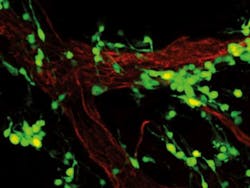Fluorescence microscopy aids in melanoma development discovery
Using fluorescence microscopy, an interdisciplinary team of researchers from the University Hospital and the LIMES Institute of the University of Bonn in Germany has discovered that sunburns contribute to the development of malignant melanoma—not only through direct alteration of pigment cell genomes, but also indirectly through inflammatory processes in the surrounding tissue.
Melanoma is particularly dangerous because it can form metastases in vital organs such as the lungs, liver, or brain. Ultraviolet (UV) radiation is considered to be the most significant triggering factor.
Related: Photoacoustic device detects melanoma at the cellular level
Related: Two-laser system improves melanoma diagnosis
"The inflammatory reaction of the skin after severe sun exposure promotes the early migration of melanoma cells along vessels within the body," says Prof. Dr. Thomas Tüting, professor of Experimental Dermatology at the University of Bonn Hospital, who led the work.
To understand the development and early metastasis of malignant melanoma, the researchers developed experimental models in mice, which allowed them to investigate the effect of inflammatory responses following UV exposure. "We repeatedly observed increased melanoma metastases in the lungs of UV-irradiated mice," reports dermatologist Dr. Evelyn Gaffal. Analyses of melanoma tissue sections revealed the spread of tumor cells along blood vessel surfaces in inflamed skin. Using fluorescence and electron microscopy methods, the researchers observed a close association between melanoma cells, inner blood vessel walls, and immune cells, especially neutrophils.
Further experiments showed that neutrophils play an important role in metastasis. They are attracted by alarm signals emitted by UV-damaged keratinocytes in the epidermis. The use of special mouse strains, which lack important molecules required for the activation of innate immune defense, shed light on the underlying signaling pathways.
Researchers in the LIMES Institute developed new experimental methods to investigate the interaction between melanoma cells and cells of the inner blood vessel walls, known as endothelial cells. In doing so, they observed that melanoma cells can migrate particularly effectively on blood vessel surfaces. "Melanoma cells increase their motility in an inflammatory environment," says Prof. Dr. Waldemar Kolanus.
Further investigations with human melanoma cells and modern genomic methods provided insights how inflammatory mediators stimulate melanoma cells migration. "During embryonic development pigment cell precursors travel long distances along blood vessels in the body in order to reach their final destination in the skin. These migratory programs are erroneously reactivated in melanoma cells by inflammation," says Prof. Dr. Michael Hölzel from the Institute of Clinical Chemistry and Clinical Pharmacology.
"Our findings may explain why patients with superficially ulcerated melanomas and neutrophil infiltration frequently develop organ metastases," says Tüting.
The researchers hope to develop new forms of targeted therapy in the future that specifically interfere with inflammatory signaling cascades and inhibit the migration of melanoma cells on the surfaces of blood vessels.
Full details of the research team's results appear in the journal Nature; for more information, please visit http://www.nature.com/nature/journal/v507/n7490/full/nature13111.html.
-----
Follow us on Twitter, 'like' us on Facebook, and join our group on LinkedIn
Subscribe now to BioOptics World magazine; it's free!
